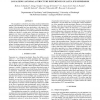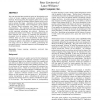692 search results - page 105 / 139 » Segmenting molecular surfaces |
112
click to vote
ECCV
2000
Springer
16 years 1 months ago
2000
Springer
A probabilistic deformable model for the representation of brain structures is described. The statistically learned deformable model represents the relative location of head (skull...
ISBI
2007
IEEE
15 years 5 months ago
2007
IEEE
The amygdala is critical for processing emotional information and plays an important role in late-life depression (LLD). Volumetric studies of the amygdala have been inconclusive ...
112
click to vote
IROS
2006
IEEE
15 years 5 months ago
2006
IEEE
— We present a robust strategy for docking a mobile robot in close proximity with an upright surface using optical flow field divergence. Unlike previous approaches, we achieve...
SIGGRAPH
1994
ACM
15 years 3 months ago
1994
ACM
The work described here extends the power of 2D animation with a form of texture mapping conveniently controlled by line drawings. By tracing points, line segments, spline curves,...
CVIU
2006
14 years 11 months ago
2006
Statistical shape-and-texture appearance models use image morphing to define a rich, compact representation of object appearance. They are useful in a variety of applications incl...


